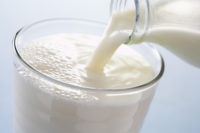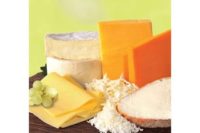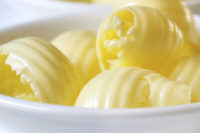The weekly price of a pound of butter has remained high throughout most of 2011, according to the United States Department of Agriculture’s National Agricultural Statistics Service. It peaked at nearly $2.15 this summer and stayed above $2 for most of the first 40 weeks of the year (see graph). Sales of butter rose nearly 21%, while units fell 2.5% in the 52-week period ended Aug. 7, according to Chicago-based market research firm SymphonyIRI Group.
“Strong markets, coupled with a soft economy, have negatively impacted demand in the retail and foodservice sectors,” says Jim Walsh, vice president of marketing for Associated Milk Producers Inc., New Ulm, Minn.
High prices are one reason butter makers are looking at how they can produce a lower-cost product for foodservice users. The average restaurateur, seeking to lower operating costs, is asking for butter blends, says Trevor Wuethrich of Wuethrich Creamery Co., Greenwood, Wis. Restaurant owners tell Wuethrich that diners won’t notice the difference between a blend and 100% butter. Consequently, a 2012 goal for the creamery is to develop a better butter blend, Wuethrich says. The company sells its own branded butters (including Grassland, Wüthrich, Country Cream and Fall Creek) and co-packs others’ brands.
Private-label butters outsell the top brand 2:1. Land O’Lakes, St. Paul, Minn., makes the best-selling branded butter. Sales of its Land O Lakes brand increased 20% to $375.5 million and unit sales grew by 2.2%, towering over all other brands. Sales of the No. 2 brand, Challenge Butter (Challenge Dairy Products, Dublin, Calif.), were a mere $57.2 million.
Land O’Lakes perhaps made the biggest noise in the category this year with its Cinnamon Sugar butter spread sold in a 6.5-ounce container. The product embodies two trends in butter — spreadability and added flavor.
“We have seen growing popularity in the spreadable butter category, with an 11.3% increase in 2010,” says Angela Pengelly, the company’s marketing manager. She says that spreadable butters are helping to increase sales in the butter category at the retail level.
The company markets the food as a breakfast spread and as an ingredient in dinners, side dishes, sweets and desserts, recommending its use, for example, on cooked carrots and grilled cheese sandwiches and in couscous recipes.
In March, Challenge Dairy, introduced Tuscan-style butter under the Challenge brand in the spreadable butter category. The butter is infused with slow-roasted garlic, olive oil and Italian herbs, including rosemary, basil, oregano and thyme. It is packaged in 7-ounce containers.
Non-traditional use of butter is as an hors d’ouevre. Tripp Hughes, category manager for Organic Valley, La Farge, Wis., says he spreads the company’s pasture butter on crackers and serves them to his dinner party guests. Pasture butter is made in the spring and summer while cows are feeding on grass outdoors. As a result of this diet, the milk is higher in conjugated linoleic acids, which is said to improve the taste of the resulting butter. To guarantee a year-round supply, processors store excess butter to sell in the winter months. (Pasture butter can only be made while the cows are grazing outdoors because a typical wintertime dairy diet does not produce high CLA levels.)
Regarding health and wellness, Wuetrich sees a role for butter as a delivery system for functional ingredients, including Omega-3s. And by blending canola or other heart-healthy oils into butter products, the foods gain a healthy halo and perception of being better-for-you.
The cachet of a limited-edition butter elevates the product above the level of a commodity. Hughes says Organic Valley exhibits the butter at beer tastings, in the belief that those who appreciate fine beer also have a taste for fine dairy products.
Cabot Creamery Cooperative, Cabot, Vt., also sees consumers moving toward better food, including butter.
“In the specialty sector, there is growing interest in butter, largely in the deli case with some spillover into dairy. With the natural and local movements gaining ground, butter has a role to play there that has only just begun to be realized,” says Amy Levine, director of marketing. She sees an opportunity to capitalize on the appeal of buying natural and locally made foods, two trends that favor butter over spreads. “Specialty butter offers opportunity in both dairy and deli.”
Though the drop in unit sales is worrisome, if prices remain high, butter makers should continue to churn more dollar sales.
|
Butter Makers Are Talking About:
Butter Up That Bacon |







